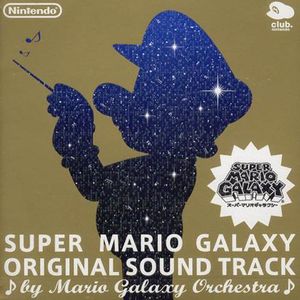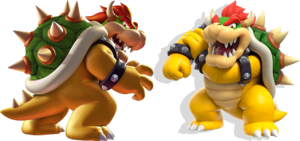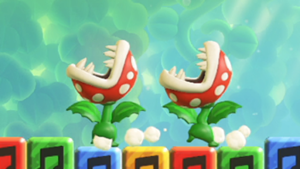The 'Shroom:Issue 200/Mario: The Musical
If you've played Super Mario Bros. Wonder, you'll certainly be familiar with Piranha Plants on Parade, the game's second level. The team at Nintendo chose to surprise every gamer out there by introducing a seldom-seen mechanic - a musical number.
In fact, Wonder has a very special emphasis on music across each and every level. Looking past the wonderfully composed and orchestrated level themes, percussion and instrumentation changes and shifts depending on the action of the player.
Despite the widespread success and appeal of the various Mario soundtracks over the decades (and those soundtracks are, in my opinion, technical and artistic achievements), Koji Kondo has always been keen to clarify in interviews that in Mario, music should be in service of gameplay. Meaning that, ultimately, a game's music should be there to enhance how the game feels to play. It doesn't matter how it sounds out of context! This was really interesting to me, and I'm sure it is to a lot of readers familiar with the soundtracks, too. While there is definitely a distinction between music used to score a game, movie, or other piece of media ("background music") and music produced as standalone works of art, video game soundtracks are often regarded as just as amazing as their contemporary counterparts. Can video game music truly do it all?
It's not a stance taken by every video game sound director, though, and opinions will naturally vary across studios, cultures, and so on. It's become increasingly common for studios to license out 'real' music for use in their games, or to bring in popular artists to put their own spin on the soundtrack. It can work very well, but I personally prefer music made by video game composers for video games, over licensed or stock music. Sometimes bringing in 'real' music can actually create a clash with what the game's trying to achieve. It's a little boring, too.
Anyway, let's examine exactly how video game music is used to heighten the average gamer experience, and then you'll have to promise me you won't just go back to listening to like, the Undertale soundtrack. Just because background music is essential to good game feel, doesn't mean you should disregard the millions of 'real' music performances out there. Please. Give it a go if you haven't already.
Motif
There's a couple of tunes in the Mario series that I'm sure any fan would instantly recognise, most of which come from the first Super Mario Bros. The overworld, underground, and Super Star songs have been used over and over again for the last 35 years. Everyone knows them, everyone loves them. Those are the songs that make you think Mario. You don't even need the full song, just that classic 'da-da da da-da DA'. This is what's known as a motif, or leitmotif if you're fancy* - a characteristic tune or rhythm that is associated with a person or place (or, sometimes, an item). Video games use it to reinforce a player's connection with certain key ideas.
It's become more common over the years - Captain Toad's always had the same musical theme since his debut, Peach's Castle has had the same melody playing since 1996, and they love throwing in the Luigi's Mansion theme in subtle places. I consider this to be more fanservice than good game design, since it doesn't have any bearing on the game itself, but throws in a nod to long-time fans.
It's not just about music being reused across games, though. A lot of Mario games establish their own unique main theme and reuse it many times over the full experience. Super Mario 64 did this a lot - the overworld theme, snow mountain, slide, and even the fanfare that plays when you get a star, they all stem from the same melody, with changes to the rhythm and mood to keep it fresh.
Instrumentation helps here, too. Think back on Bowser's musical accompaniments in recent games, and you may notice that he's been leaning much more towards metal and jazz genres, with lots of electric guitars and saxophones, in comparison to Super Mario Galaxy's take, which was a very serious and yet over-the-top orchestral blowout. It depends on what the composers want Bowser to be. Sometimes, he's a VERY evil turtle bent on world domination, which calls for the aforementioned orchestra to send home the idea that the stakes are high and you are the saviour of the universe for defeating him. Sometimes, he's just a goofy bad guy who wants to capture princesses and punch Mario in the face. In those cases, the songs are much more fun to listen to. The 'badness' of the character is conveyed through the instruments (distorted guitar, bass saxophone, etc) rather than the motif.
As another example Super Mario 3D World, Captain Toad's theme is scored with mostly woodwinds like flutes and clarinets, which reminds the listener that he's a light-hearted, bouncy character (not literally bouncy. He's very heavy, I've heard). But the percussion is structured like a march, which prompts the player to keep pushing forward, even when everything's cute and playful. However, when this guy got his own game, his theme was rewritten for a full orchestra. The core of the song is kept the same, so it still sounds very fun, but the addition of brass and strings makes it sound more epic overall, emphasising that this is a true adventure unlike anything Captain Toad's seen before.
So, even when music isn't directly interfacing with the gameplay, it still has an important role within the context of the game's story and presentation. It can't just sound good. It has to sound right, otherwise you leave the player confused, bewildered, and possibly in pain. The role of the music, in this most basic sense, is to provide a player with the proper emotional mood, be it cool, fun, or creepy. If you don't believe me, swap the underground and overworld music of any Mario game and you'll just know that it sucks.
(*Technically, leitmotif is the accurate name for it. A motif can be any distinct melody, and only when it becomes associated with a unique thing does it gain the 'leit'. But a wise composer once tweeted that saying 'leitmotif' every time makes you a fancy pants nerd, and I have adopted that stance unquestioningly. I am not a fancy pants nerd.)
Dynamic/responsive music
Music can do much more for the player when it responds to what the player is doing. A big part of 'game feel' is understanding the impact you can have on the game, beyond the actions of your character. Good game feel is rooted in immersion, intuitive controls, and responsive sound and visuals. It can be simple (though often not easy) to create immersive visuals, and Mario games keep on getting better at this through lots of particles, reactive characters. It all adds up to a very satisfying moment when you stomp on a Goomba.
When the music is dynamic, it can heavily contribute to this immersion. In a very basic sense, Mario music has always been dynamic, as the music changes based on the level or area you visit. This has been true since Super Mario Bros. on the NES! Having different music for different areas is an easy way to immerse the player, linking back to what we saw earlier with leitmotifs. A more interesting idea is to have the music for an level evolve as you get closer to the goal, such as in Super Mario 3D World's Switch Scramble Circus. The dedicated music track for this area was split up into sections, with each challenge in the level getting its own part of the full song. So, when you beat a section and move on, the music also moves on, only changing when you do! It all culminates in a triumphant fanfare, masterfully written and performed right as you start to approach the flagpole. What a special level.
This is a great example of immersive music. The evolving music, combined with the actual level (platforming in a flashy, fun carnival area) makes you feel like you're part of the whole performance. The level wouldn't be nearly as effective with a static, unchanging music track.
Just as the melody and instrumentation sets the tone of the game, the percussion (typically referring to the drums and other instruments that make a 'beat') sets the energy. More percussion often makes the music feel more complex and intense, which can be used to encourage the player to keep on going. This has been a staple of Mario since Super Mario World, where riding Yoshi would add additional bongos to the background music. 'Yoshi Bongos' would continue to be used throughout the series, in most platformers where he appeared. It lets the player immediately understand that the gameplay's going to be a little different, that they've got a lot more potential and can let loose.
This idea has also been applied in the Mario Kart series. If you're an elite gamer, I'm sure you'll know that when you're able to hold a first place position for more than a few seconds, the music ramps up and adds an additional layer of extra-fast drums, as if to say "Yeah, you can do this! Keep going!". I think it's really good when a game doesn't just reward the player for doing well, but also celebrates their success through its presentation.
In Super Mario Wonder, all of these ideas culminate and combine in one big dynamic package. Not only do you have drums fading in and out to match the energy of the player, but you also have what I'm calling 'Elephant horns', where the music shifts to a brass arrangement if you're in Elephant form. BUT, you ALSO have music that changes based on your progress in Bowser's Blazing Beats, AND you have that emphasis on the performance with characters and enemies dancing to the music. AND, in a very special case, you can kill the singing Piranha Plants. This actually stops them from singing, in case you're a huge hater of the singing plants.
That's a case of diegetic music, where the songs are actually happening in the game, instead of just appearing as background music to us players. It's the peak of immersion, and Super Mario Wonder executes it very well. I don't think it's a requirement for immersion or game feel, and I can think of cases where it would actually be detrimental to the overall experience, especially in 'serious' moments. I don't think the final boss in Super Mario Galaxy would be improved if you could look in the distance and see a choir of Goombas popping off.
Rhythm
Rhythm games demand that all the player's actions are timed to the music, typically the 'beat'. Something appears on screen and it's up to the player to respond in a timely manner, often in sync with the tune. In a sense, the concept has been used many times before Wonder. Autoscrolling levels demand the same thing - obstacles show up in a set order with a set timing, and you get a short amount of time to clear the obstacle before it goes off-screen and you lose the opportunity. Do things quickly and repeatedly, there's no time to wait!
The difference between rhythm challenges and other timing-based ones is the predictability. Anyone who vaguely knows what music should sound like will understand what a 'beat' is, even if they can't describe it. Any and all challenges will align themselves to that simple 1, 2, 3, 4, metronome, and your actions as a player will probably follow that kind of pattern, too.
The other difference is, of course, immersion, which you're probably sick of hearing about by now. But yes, incorporating the music with the rhythm challenge not only gives the player a memorable audio cue for the level, which makes it easier to remember what you need to do ("ah, when the big one starts singing, I need to get to the back and avoid these plants"), it also adds to that feel of taking part in a big performance, which can make the whole thing a lot more fun when the level gets frustrating or challenging.
There's a risk, however, when the obstacles are timed to the music, but the player's actions aren't. If the rhythm is too fast, the player might have to forego any notion of good timing just to desperately keep up with the level, no matter what. When the rhythm of the level is in sync with the music, but clashes with the rhythm of the player, it can get confusing and make for poor game feel. The player might even try and mistakenly time their jumps to the beat, only to be punished. The true intended rhythm for the player is discordant with the music. That's no good.
Wonder
Let's bring it back to Piranha Plants on Parade. Super Mario Bros. Wonder is a reportedly unique case for Nintendo developers, as all members of staff working on the game were allowed to pitch in with their own ideas. I think it's that power given to the sound team that led to so many interesting uses of music intertwining with gameplay, some of which had never been seen before in the series. And it's no surprise that those ideas became some of the game's most memorable moments - from the famous singing plants to the rhythmic perfection demanded by having to jump to the beat. I really, really hope that this level of musical integration is present in future platformers and other action games across the board.
Anyway, thanks for reading. Sound is a key, but often overlooked component of what makes a game feel good to play, but it's not all music, of course. Having responsive, unique sound effects and great atmospheric ambience can contribute just as much to game feel. And if you want to explore the topic further, I'd recommend looking through various interviews Koji Kondo has given over the years. Enjoy yourselves.


